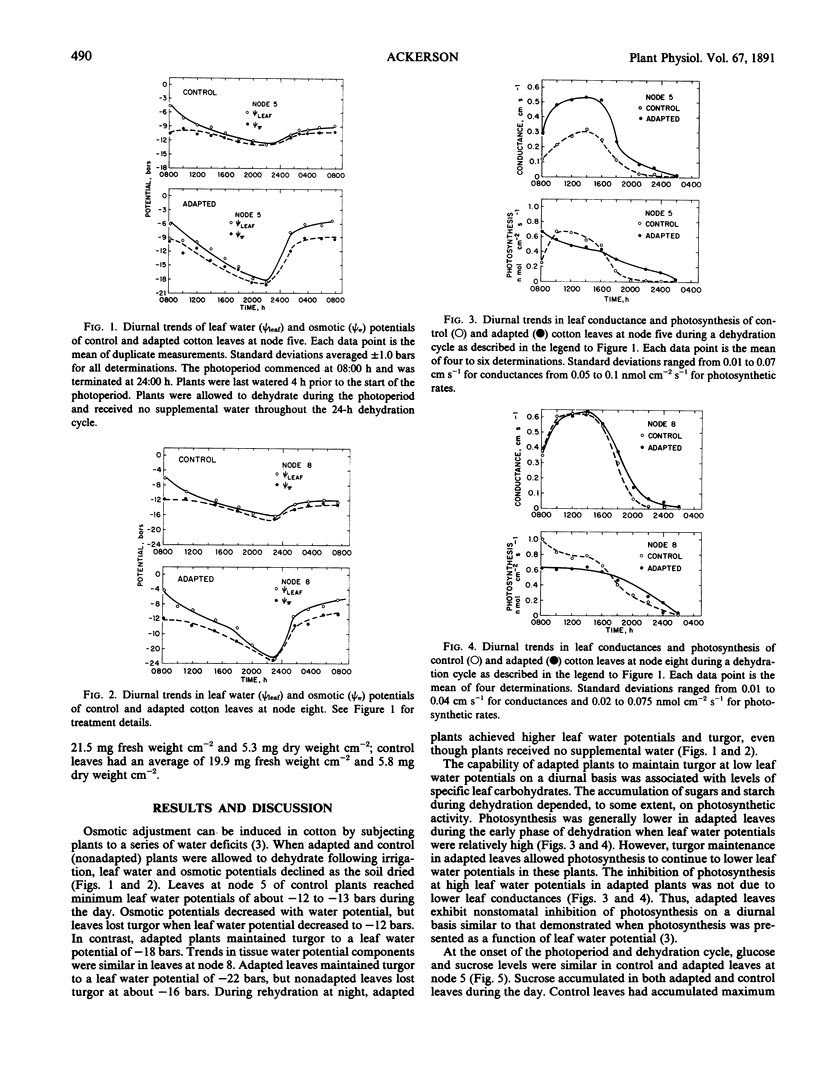Abstract
Diurnal changes in tissue water potential components, photosynthesis, and specific leaf carbohydrates were examined in water stress-adapted and nonadapted cotton plants. Adapted plants exhibited lower daily minimum leaf water potentials and maintained turgor to lower leaf water potentials than nonadapted plants. Because of this turgor maintenance, photosynthesis continued in adapted plants at leaf water potentials that inhibited photosynthesis in nonadapted plants. Adapted plants exhibited lower rates of photosynthesis than did nonadapted plants when leaves were fully turgid. The inhibition was not due to stomatal restriction of CO2 diffusion because leaf conductances of nonadapted and adapted leaves were similar at high leaf water potentials.
Adapted plants had more glucose than nonadapted plants, the pattern of glucose accumulation depending on leaf age. Sucrose accumulation in response to decreasing water potential also depended on leaf age. Adapted young leaves exported sucrose, whereas nonadapted leaves of the same age accumulated sucrose at the same leaf water potential. Older leaves of both adapted and nonadapted plants accumulated sucrose as plants became stressed during the day.
Old, fully expanded leaves from adapted plants contained up to 5 times more starch than did nonadapted leaves, although the kinetics of starch accumulation and degradation were similar in adapted and nonadapted leaves. In young leaves, adaptation did not affect starch accumulation.
When adapted plants were destarched by 80 hours darkness, they became “de-adapted” plants. In nonadapted and de-adapted plants, photosynthesis, leaf conductance, and leaf turgor responded identically to declining leaf water potentials. The data implicate starch in the regulation at cellular nonosmotic volume and, thus, osmotic adjustment.
Full text
PDF




Selected References
These references are in PubMed. This may not be the complete list of references from this article.
- Acevedo E., Fereres E., Hsiao T. C., Henderson D. W. Diurnal growth trends, water potential, and osmotic adjustment of maize and sorghum leaves in the field. Plant Physiol. 1979 Sep;64(3):476–480. doi: 10.1104/pp.64.3.476. [DOI] [PMC free article] [PubMed] [Google Scholar]
- Ackerson R. C., Hebert R. R. Osmoregulation in Cotton in Response to Water Stress : I. ALTERATIONS IN PHOTOSYNTHESIS, LEAF CONDUCTANCE, TRANSLOCATION, AND ULTRASTRUCTURE. Plant Physiol. 1981 Mar;67(3):484–488. doi: 10.1104/pp.67.3.484. [DOI] [PMC free article] [PubMed] [Google Scholar]
- Ackerson R. C. Stomatal response of cotton to water stress and abscisic Acid as affected by water stress history. Plant Physiol. 1980 Mar;65(3):455–459. doi: 10.1104/pp.65.3.455. [DOI] [PMC free article] [PubMed] [Google Scholar]
- Jones M. M. Osmotic adjustment in leaves of sorghum in response to water deficits. Plant Physiol. 1978 Jan;61(1):122–126. doi: 10.1104/pp.61.1.122. [DOI] [PMC free article] [PubMed] [Google Scholar]
- Nafziger E. D., Koller H. R. Influence of Leaf Starch Concentration on CO(2) Assimilation in Soybean. Plant Physiol. 1976 Apr;57(4):560–563. doi: 10.1104/pp.57.4.560. [DOI] [PMC free article] [PubMed] [Google Scholar]
- Outlaw W. H., Manchester J. Guard cell starch concentration quantitatively related to stomatal aperture. Plant Physiol. 1979 Jul;64(1):79–82. doi: 10.1104/pp.64.1.79. [DOI] [PMC free article] [PubMed] [Google Scholar]
- Thorne J. H., Koller H. R. Influence of assimilate demand on photosynthesis, diffusive resistances, translocation, and carbohydrate levels of soybean leaves. Plant Physiol. 1974 Aug;54(2):201–207. doi: 10.1104/pp.54.2.201. [DOI] [PMC free article] [PubMed] [Google Scholar]


